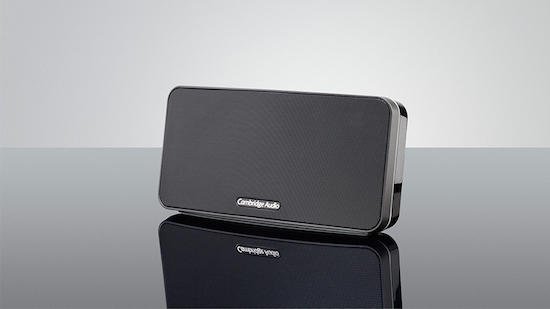
The Cambridge Audio Go is an all-around improvement to the Cambridge Audio Minx Go portable Bluetooth speaker. You can start with the name: someone realized (or "realised," since they're British) that "minx" has some less-than-flattering slang connotations for women.
The Go retails for $179 and a fantastic-sounding speaker for the price. If you search for "Cambridge Audio Go" online, you'll get a lot of links to buy the still-available Minx version. You want the new one. Click here to order the right version from Amazon via the Cambridge Audio website.

The speaker measures 9.3" x 4.8" x 2.4" and weighs about 2.5 lbs. It comes with a cloth bag for protection when you throw it in a suitcase. Bluetooth pairing is easy enough with an iPhone and dead-simple with the NFC pairing built into most new Android phones: just tap your phone on the logo and you're connected. It also features the superior aptX Bluetooth streaming technology for devices so equipped. You get a choice of white or black.
I pulled the speaker out of the box and put the power cord in my suitcase before a trip. I used it through the weekend and took it on a second trip, using it for over 20 hours (!!) before the battery gave out. Unfortunately, the Go comes with 3 adapters for US, UK and European power outlets and it was the UK adapter that was connected out of the box. We had a backup speaker in our group but everyone had gotten enough of a taste of the Go that we missed it all week.

There's a USB out port on the back, so you can divert some of that awesome battery life to charging a phone or tablet. You can also attach any audio device via the 3.5mm aux port. The rear-firing bass radiator really give some nice (but not over-exaggerated) low end.

Controls are dead simple: there's a power button on the top, along with volume up and down, aux and Bluetooth pairing buttons. The Go isn't designed for insanely high volumes, but it sounds amazing for home use in a kitchen or a bedroom. It travels easily and, if you've got room in a suitcase, it's a huge upgrade in any hotel room.
I'm not the only one who loves it. The UK's What HiFi? magazine just named it 2014's best wireless speaker under £150. This is now the speaker I'll recommend to friends who can afford to spend $200 on a wireless speaker. The only speaker on the horizon that might replace this is the upcoming Go Radio, which adds an FM radio and antenna. If Cambridge Audio manages to add a quality FM radio for only $20 more, that will be the killer home audio device.
Why might you want to choose a different speaker? The Go isn't really going to work as a music source for a massive party. There may be other sub-$200 speakers that get louder, but none of them sound this good. The Go also isn't designed to take a huge amount of abuse. There's a small light on the front of the speaker that shines blue if you've got a Bluetooth connection and red if you don't. It's really easy to see from across a room if you've got a connection and it's really, really easy to see from across a dark room in the middle of the night if that sort of thing bothers you. If you're looking for something to take camping or to the beach, you might want to look at the Outdoor Tech Turtle Shell or the ECOXGEAR ECOSTONE wireless speakers.
If none of those sound like concerns for you and you've got $200 to spend, the Cambridge Audio Go is definitely the first speaker you should consider.




